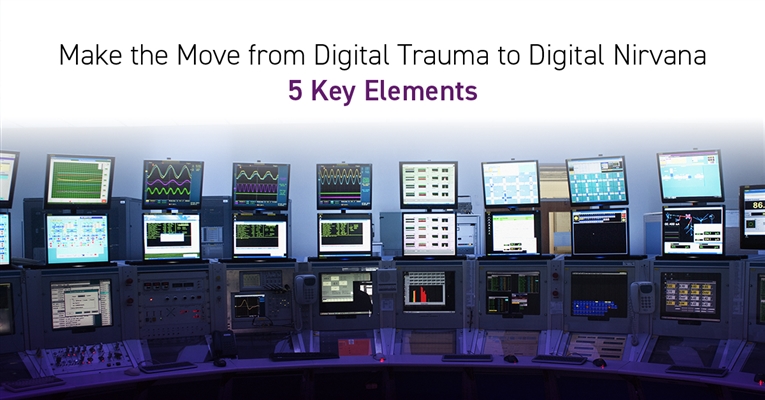If you tried to perform a routine process with your product lifecycle management (PLM) software, made decisions without accurate data, or collaborated across departmental boundaries using meetings and spreadsheets you’ve likely experienced some level of “digital traumatization.”
New demands to adapt product development processes to support supplier collaboration, information sharing between engineering disciplines, flexible sourcing strategies, and digital transformation projects are uncovering the ugly truth and incompetence of yesterday’s product lifecycle management solutions.
Avoiding digital trauma is possible when companies create a sustainable focus on engineering and manufacturing users in need of product information and incorporate five powerful elements that will spur the move from digital trauma to digital nirvana.
This approach reduces risk and disruption of the product development cycle while transforming your business, providing more business value, achieving greater business resiliency, and becoming more agile with happier and more motivated high-performance teams.
What causes digital trauma?
How did organizations wind up enveloped in digital trauma? There are a host of reasons, and like most things, you may not even realize you are in the middle of experiencing digital trauma because you are just trying to move things forward in order to meet business goals. For the most part, this trauma is a slow-moving train, created by ever-changing business strategies that affect product mix, organizational changes, and the business processes to meet new objectives.
To keep pace, you keep adding to the portfolio of solutions you think will deliver the efficiencies required. This amalgamation of software offerings is acquired separately over time to solve one-off requirements. That creates a complexity of integrations, different user interfaces, and requests from the business to add more monitors to see each application.

Moving from digital trauma to digital nirvana requires organizations to move from portfolio to platform thinking.
What is digital nirvana?
Creating a resilient enterprise ecosystem requires a massive amount of change — meaning new ways of thinking, connecting, and collaborating — all of which need access to a precious and often misunderstood resource — product information. This requires a move from a portfolio to a platform strategy.
The critical differentiator that platforms create is the efficient and effective use and connecting of product data. If you want your extended enterprise ecosystem to be resilient and adapt to constantly changing market and business dynamics, this is your only choice – and it is the cure to digital trauma.
Portfolio strategies fail because they are too simple – it’s about more than just connecting siloed data. A successful digital transformation, one that will help you move closer to digital nirvana, requires new processes, the flexibility to disrupt standard operating procedures, and letting go of comfortable, one-dimensional, and outdated tools.
Achieving digital nirvana requires that product data is available to all who need it, keeping it secure enough to move throughout the enterprise so users have access for any need, in any role, at any time.
5 power elements to look for…
1. Data transparency. An open platform allows organizations to own their data instead of leaving it captive to an aging technology or a software vendor.
2. Business process adaptability. Processes will change and will do so often, quickly, and without concern for the ability of the systems to change with them. The right platform is so adaptable that it not only supports change but encourages it.
3. Evolving technologies. A platform should never be locked into a technology. For a platform to be continually relevant over time, there must be flexibility in the design, keeping to open standards.
4. System customizations. Since every company is unique, and every business process evolves, a platform must be able to implement customizations without impacting future upgrades or creating crippling technical debt.
5. Enterprise SaaS. To keep pace, it’s no longer just about moving to the cloud but adopting a SaaS platform that spans your enterprise product ecosystem. This frees up resources to focus on what matters most to your organization.
Answer the following questions to assess your readiness
To determine if you have the right solutions in place to move from reactive to resilient and get out of a state of digital trauma, we developed the following questions. If you answer “no” to any of these, you more than likely have a large portion of your business systems trapped in a portfolio strategy. It’s time to break free from the technology and processes that are holding you back.
Is your platform customizable? Once customized, can you upgrade easily and without data loss?
Look for a platform with underlying technology that is flexible, scalable, and upgradeable—even when heavily customized.
Does your platform enable the creation of an end-to-end digital thread?
It is critical that solutions sustainably connect data throughout the entire lifecycle—breaking down information silos and fostering collaboration.
Does your platform give you the flexibility to meet process requirements that don’t exist today?
Out-of-the-box software may be able to meet today’s needs but the digital processes of tomorrow don’t exist today. Solutions should offer flexible customization to meet ever changing needs without sacrificing upgradeability.
Does your platform give you total data transparency?
It’s your data, you should own it instead of leaving it captive to aging technology or a software vendor’s native software.
Does your platform provider try to make you fit their single deployment model?
There should be a choice when it comes to deployment. On-premise, in a data center, in the cloud, or a combination for a hybrid deployment. Whatever works best for you!
Can your platform evolve technically?
Solutions should evolve over time and adapt to new and improved technologies without extensive redesign efforts.
Bottom line, if your technology is not (1) transparent - as technology changes, the data inside the technology does not; (2) evolvable – solution selection doesn’t lock you into one specific technology; and (3) adaptable - supporting and embracing constant change, it will take too long to break out of your old and outdated business model.
Ready to make the move? Join the conversation here.

